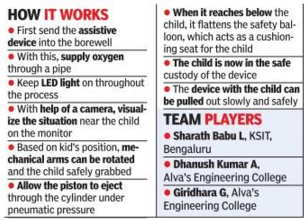
Bengaluru:
With children falling into borewells now a common phenomenon, mechanical engineering students Sharath Babu L, Dhanush Kumar A and Giridhara G set about finding a solution to save those trapped.
They came up with a simple pulley system to lift up babies who accidentally fall into open wells or borewells, giving a humane touch to their budding careers.
Researching the subject, they found that 14 babies had fallen and died in open borewells in 2014. Till the end of 2015, 36 children had died in a similar manner.
“This was around August, when a six-year old boy had fallen into a borewell in Sulikere village in Bagalkot district. The incident moved us, and our teacher also suggested that we try and find a solution,” said Sharath Babu.
The three students were then pursuing a diploma in engineering and had to submit a project to get their degree. They are now in the second year of engineering in different colleges in the city. This pulley is better than those used in times of crisis, because it has a camera and LED light fitted in, that enables rescuers to locate the baby in a dark borewell.
“The images captured by the camera can be seen through a computer by people managing the rescue on the ground. We also send oxygen through assistive devices. Once the baby is found, the pulley covers the baby entirely and a balloon-like cushion is remotely swollen to help hold it securely.
There are side covers of the pulley that grip the hands of the victim and it is pulled out through the simple mechanics of a pulley system.
The boys have already shaped a prototype and done experiments to make it a market-ready solution. “But our problem is we’ve devised it out of reused materials like aluminium, cardboard, simple steel strings and a deflated football. We are trying to mobilize resources to develop this product that will save many children in rural areas across India,” said Dhanush.
HOW DOES IT WORK?
* First send the assistive device into the borewell
* With this, supply oxygen through a pipe
* Keep LED light on throughout the process
* With help of a camera, visualize the situation near the child on the monitor
* Based on kid’s position, mechanical arms can be rotated and the child safely grabbed
* Allow the piston to eject through the cylinder under pneumatic pressure
* When it reaches below the child, it flattens the safety balloon, which acts as a cushioning seat for the child
* The child is now in the safe custody of the device
* The device with the child can be pulled out slowly and safely
TEAM PLAYERS
Sharath Babu L, KSIT, Bangalore
Dhanush Kumar A, Alva’s Engineering College
Giridhara G, Alva’s Engineering College
source: http://www.timesofindia.indiatimes.com / The Times of India / News Home> City> Bangalore / TNN / February 15th, 2016
